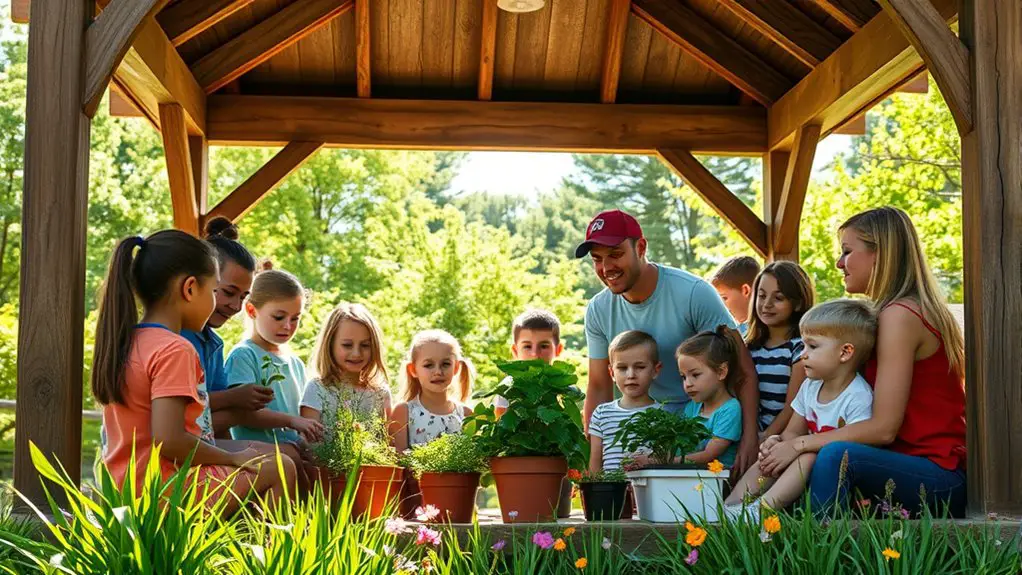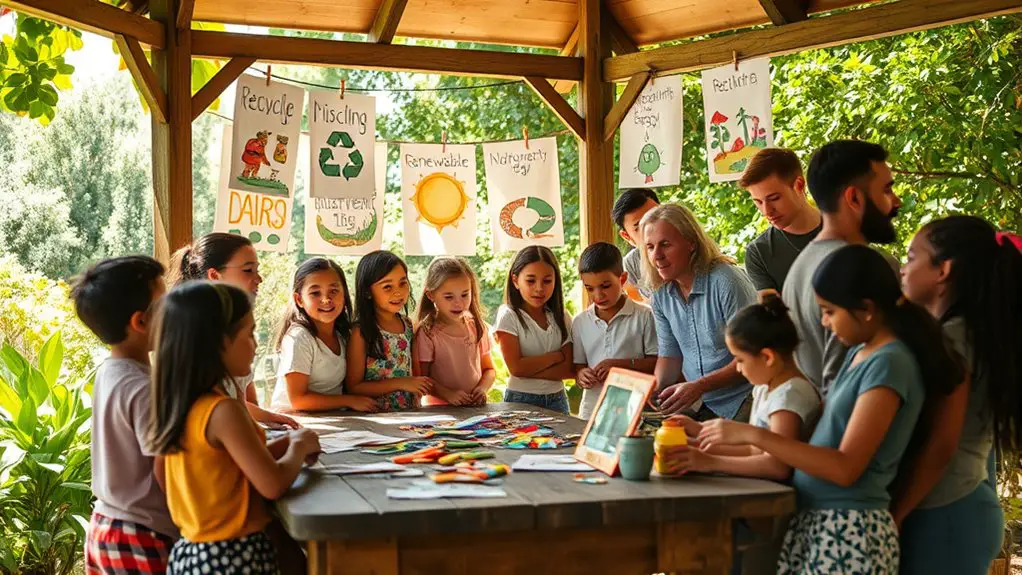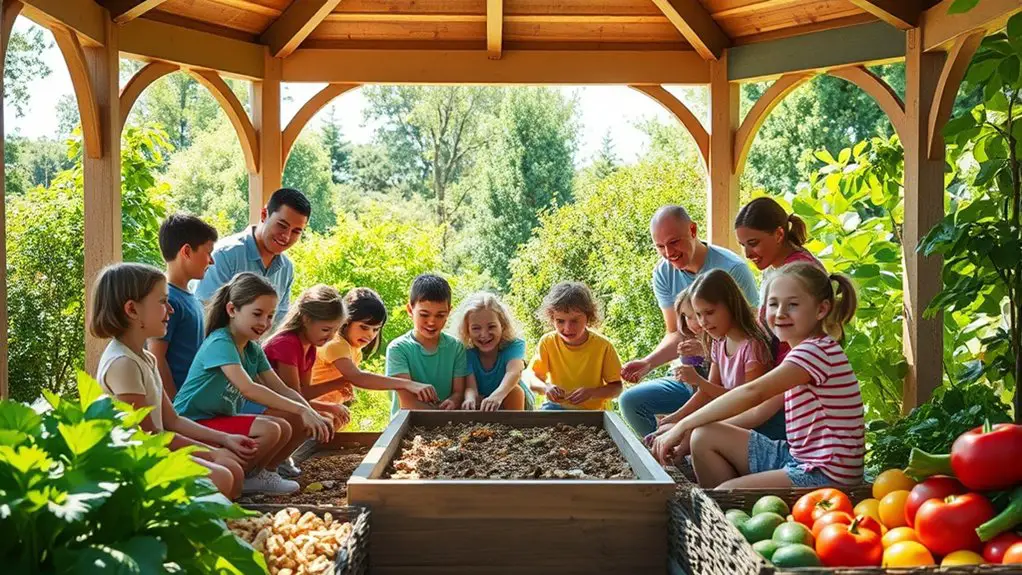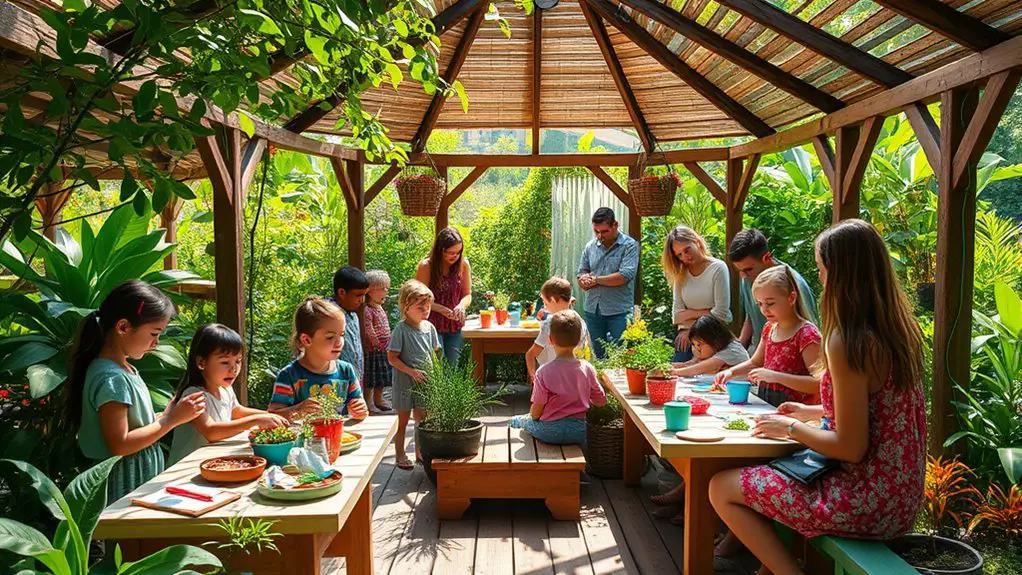Teaching sustainability in a gazebo is a fantastic way to connect with nature while learning. You’ll engage in hands-on activities like nature crafts and community gardening, which spark creativity and promote environmental responsibility. The gazebo provides shade and comfort, making discussions about recycling and renewable energy enjoyable. You can encourage community involvement through clean-up events and workshops. With so many engaging opportunities, you’ll discover effective ways to build a sustainable future in your community.
The Benefits of Outdoor Learning Environments

When you step outside into an outdoor learning environment, you might discover that nature can be just as effective a teacher as any classroom. Outdoor exploration opens up a world of possibilities, allowing you to engage with your surroundings in a way that’s both stimulating and freeing. By immersing yourself in nature, you foster a deeper nature connection, leading to enhanced creativity and critical thinking skills.
Learning outside encourages hands-on experiences, making lessons more memorable. Whether it’s observing wildlife, studying plants, or simply enjoying the fresh air, being outdoors can ignite curiosity and inspire a love for learning. It also promotes physical well-being, reducing stress and increasing focus. Moreover, outdoor environments can cultivate environmental awareness, nurturing a sense of responsibility toward the planet. Additionally, shade and shelter provided by structures like gazebos can enhance outdoor comfort during learning sessions, making them more enjoyable for all participants. So, take a step outside, embrace the natural world, and let it guide your learning journey toward sustainability.
Creating a Welcoming Gazebo Space
To create a welcoming gazebo space, you’ll want to focus on inclusivity, ensuring everyone feels comfortable and engaged. Incorporating natural elements can enhance the ambiance, while thoughtful seating arrangements invite conversation and collaboration. When you design with these points in mind, you’ll foster a vibrant outdoor learning environment that encourages sustainability. Adding flower gardens around the gazebo can also create a soothing atmosphere that promotes relaxation and connection with nature.
Design for Inclusivity
How can a gazebo become a truly inclusive space for everyone? By embracing adaptive design principles, you can create a welcoming environment that meets diverse needs. Start with universal accessibility—ensure pathways are wide and smooth enough for wheelchairs or strollers. Consider seating options that accommodate all body types and abilities, like benches with backs and arms for support. Incorporate tactile elements for those with visual impairments, such as textured surfaces or braille signage. You might also think about shade and shelter, making it comfortable for everyone, regardless of age or ability. By prioritizing inclusivity, you’re not just building a gazebo; you’re fostering a community space where everyone feels free to gather, learn, and connect.
Natural Elements Integration
Integrating natural elements into your gazebo design not only enhances its aesthetic appeal but also creates a more inviting atmosphere for all visitors. You can incorporate nature-inspired art, like wooden sculptures or stone mosaics, to connect with the environment. Consider using recycled materials for eco-friendly crafts, such as creating planters from old pallets or decorating with driftwood. Adding potted plants or climbing vines can bring life and freshness, making your gazebo feel like a natural retreat. Natural lighting, through open spaces or skylights, further enriches the experience. By blending these elements, you foster a space where creativity thrives and everyone feels free to explore their connection with nature. Your gazebo can become a true sanctuary for inspiration and relaxation.
Comfortable Seating Arrangements
Creating a natural retreat in your gazebo isn’t just about the aesthetic; it’s also about comfort. Think about how cozy cushions can transform hard benches into inviting seats that call for relaxation. Choose cushions in natural fabrics that breathe and blend with your surroundings, enhancing that serene vibe.
Don’t be afraid to play with flexible layouts, allowing for various groupings—perhaps a circle for discussions or a cozy nook for quiet reading. You can even mix and match seating options, from bean bags to low stools, catering to both kids and adults. This adaptability invites everyone to unwind and enjoy the space. So, create a welcoming environment that encourages connection, creativity, and a shared love for sustainability in your gazebo.
Engaging Activities for Different Age Groups
Whether you’re working with toddlers or teenagers, engaging activities that teach sustainability can be tailored to suit any age group. For younger kids, nature crafts like leaf rubbings or making bird feeders from recycled materials spark creativity while connecting them to the environment. You can turn a simple walk into a treasure hunt, where they collect natural items to discuss their importance.
For older children and teens, sustainability games that challenge them to design eco-friendly solutions or compete in recycling competitions can ignite their passion for change. Consider organizing a project where they develop a community garden, allowing them to experience hands-on learning. Additionally, incorporating outdoor structures like a gazebo can provide a shelter for activities while enhancing the aesthetic value of the learning environment.
These activities not only educate but also empower participants to embrace sustainable practices. By adapting your approach to fit the age group, you create a dynamic learning environment that fosters a love for nature and responsibility towards the planet.
Interactive Discussions on Sustainability Topics

Let’s talk about how recycling can greatly reduce waste and its impact on our planet. Consider the role of renewable energy sources in powering our communities sustainably—what options do you see around you? Plus, think about how sustainable gardening practices can not only beautify your space but also contribute to a healthier ecosystem.
Importance of Recycling
Although recycling might seem like a small action, its impact on the environment can be profound. By participating in recycling, you’re not just reducing waste; you’re actively contributing to a healthier planet. The recycling benefits are immense—less energy is used in processing recycled materials compared to creating new ones, which means fewer greenhouse gases are released. Plus, it conserves natural resources, ensuring they’re available for future generations. You have the power to make a difference in your community by promoting waste reduction. Encourage your friends and family to join you in this simple yet powerful practice. Remember, each item you recycle counts. Embrace this freedom to choose sustainability, and watch how your small actions create ripples of positive change.
Renewable Energy Sources
Renewable energy sources are transforming the way we power our lives, and there are several key options worth exploring. By understanding these sustainable technologies, you can play a role in energy conservation and efficiency. Here’s a quick overview of some popular renewable resources:
| Energy Source | Description |
|---|---|
| Solar Panels | Capture sunlight to generate electricity. |
| Wind Turbines | Convert wind energy into clean power. |
| Hydroelectric Power | Uses flowing water to produce energy. |
| Geothermal Heating | Harnesses Earth’s heat for energy. |
| Bioenergy Innovations | Converts organic materials into fuel. |
Embracing these innovations not only promotes clean energy but also empowers you to contribute to a sustainable future. It’s time to make informed choices and enjoy the freedom that comes with renewable energy!
Sustainable Gardening Practices
As you plunge into the world of sustainable gardening practices, you’ll discover that every small choice can make a significant impact on the environment. Start with organic fertilizers, which enrich your soil without harming the ecosystem. By using compost or natural amendments, you’ll nurture your garden while reducing waste.
Another fantastic technique is companion planting. By pairing plants that support each other—like tomatoes and basil—you’ll enhance growth and deter pests naturally. This method fosters a thriving garden ecosystem, giving you the freedom to grow healthy food while minimizing chemical use.
Explore these practices, and you’ll not only cultivate a beautiful garden but also contribute to a healthier planet for future generations. Embrace sustainability, and watch your garden flourish!
Hands-On Projects: Building a Compost Bin

Building a compost bin is a fantastic hands-on project that not only teaches sustainability but also empowers you to reduce waste and enrich your garden. You’ll discover the compost benefits, like creating nutrient-rich soil while diverting organic waste from landfills. To start, gather materials like wood pallets or wire mesh, and design a simple bin that suits your space.
Once your bin’s up, it’s all about bin maintenance. Regularly add kitchen scraps, yard waste, and turn the pile to aerate it. Keep an eye on moisture; it should be damp but not soggy.
In just a few months, you’ll be amazed at the transformation of your scraps into dark, crumbly compost. Not only does this project give you the freedom to manage your waste sustainably, but it also connects you with nature and boosts your gardening efforts. Enjoy the journey toward a greener lifestyle!
Incorporating Nature Walks Into Lessons
While many lessons unfold within the four walls of a classroom, stepping outside for a nature walk can transform your teaching and deepen students’ understanding of sustainability. Embrace the freedom of the outdoors as you guide your students in nature observation, allowing them to witness the beauty and complexity of their environment firsthand. Encourage them to identify local plants, insects, and animals, fostering a sense of connection to the natural world.
Incorporate wildlife tracking into your lessons by showing them how to spot animal tracks or listen for sounds of wildlife. You could even create a simple journal for students to document their findings and reflections. These activities not only enrich their learning experience but also cultivate a sense of responsibility towards the environment. By integrating nature walks, you’re empowering students to appreciate and protect the world around them, making sustainability a part of their everyday lives.
Utilizing Local Resources and Expertise
After exploring the wonders of nature during your walks, consider tapping into local resources and expertise to further enrich your sustainability lessons. Local partnerships can be invaluable; connect with nearby farms, environmental organizations, or community gardens. They often offer workshops, demonstrations, and hands-on experiences that can make your lessons come alive.
Resource sharing is another fantastic way to enhance your teaching. Reach out to local experts who can share their knowledge on topics like composting, renewable energy, or native plants. Invite them to speak or lead activities in your gazebo—this not only diversifies your curriculum but also strengthens community ties.
Encouraging Community Involvement and Participation
How can you foster a sense of community around sustainability? It starts with getting everyone involved and showing them that their participation matters. Here are some practical ways to encourage community engagement:
Fostering community around sustainability begins with involvement and demonstrating the importance of each person’s contribution.
- Organize community clean ups: Schedule regular events where everyone can come together to beautify local parks and neighborhoods. This builds pride and awareness.
- Form local partnerships: Collaborate with local businesses and organizations to share resources and promote sustainable practices. It’s a win-win!
- Host workshops: Create hands-on experiences that teach sustainable living skills, from gardening to recycling. People love learning together.
- Create a community garden: Invite neighbors to cultivate a shared space. This not only produces fresh food but also strengthens connections. Additionally, you can include mosquito netting for outdoor events in the gazebo to enhance comfort while learning about sustainability.
Assessing Learning Outcomes and Impact
Building a strong sense of community around sustainability is just the beginning; evaluating the learning outcomes and impact of these initiatives is equally important. When you engage in learning assessments, you’re not just measuring knowledge—you’re gauging how well participants grasp sustainable practices and concepts. This feedback is essential for refining your programs and ensuring they resonate with everyone involved.
Impact evaluation helps you understand the tangible effects of your efforts. Are participants more inclined to adopt sustainable habits? Do they feel empowered to advocate for change in their communities? By collecting data through surveys or observations, you can pinpoint successes and areas for improvement.
Building a Sustainable Future Together
To build a sustainable future, you’ve got to engage your community and get hands-on with learning activities. By collaborating with local groups, you can create initiatives that not only educate but also inspire action. Together, let’s turn knowledge into practice and make a real impact. Incorporating features like outdoor living spaces enhances community engagement and promotes sustainability.
Community Engagement Initiatives
While many individuals recognize the importance of sustainability, the true impact emerges when communities come together to champion environmental initiatives. You can foster community engagement by building partnerships with local businesses and residents. Here are some practical ways to get involved:
- Organize Clean-Up Days: Gather volunteers to tidy up local parks and public spaces.
- Host Workshops: Collaborate with local businesses to teach sustainable practices, like composting or gardening.
- Create a Community Garden: Involve neighbors in growing food while promoting biodiversity.
- Support Local Green Initiatives: Partner with businesses that prioritize eco-friendly practices and promote them to your community.
Hands-On Learning Activities
Hands-on learning activities provide an exciting way to engage community members in sustainability efforts while reinforcing the principles discussed in previous initiatives. You can immerse yourself in nature crafts, using recycled materials to create art that reflects the beauty of our environment. Think about making bird feeders from plastic bottles or planting seed bombs to beautify your community. Eco-friendly experiments, like creating natural dyes from fruits and vegetables, can spark creativity while teaching the importance of reducing waste. Organize workshops where everyone can learn together, fostering a sense of unity and empowerment. By participating in these interactive activities, you not only gain valuable skills but also contribute to building a sustainable future that respects our planet and encourages freedom for all.
Frequently Asked Questions
What Materials Are Best for Building a Sustainable Gazebo?
When building a sustainable gazebo, you’ll want to take into account recycled materials like reclaimed wood or metal. Utilizing natural resources responsibly guarantees your structure’s eco-friendliness while maintaining durability and beauty for years to come.
How Often Should We Hold Sustainability Workshops?
Imagine if your calendar had a ‘sustainability’ emoji! You should hold monthly workshops to keep enthusiasm high, while seasonal events can create buzz and draw in new faces. Balance both for maximum impact and engagement!
What Age Is Appropriate for Introducing Sustainability Concepts?
You can introduce sustainability concepts as early as preschool. Engaging kids through family involvement reinforces learning, making it fun. Start with simple ideas and let their curiosity flourish—it’s a great way to inspire future eco-consciousness!
Can We Integrate Technology Into Outdoor Learning?
Imagine stepping into a world where nature meets technology. You can use interactive apps and virtual reality to enhance outdoor learning experiences, making lessons engaging and immersive. It’s a freedom to explore endless possibilities!
How Can We Measure Community Interest in Sustainability?
To measure community interest in sustainability, you can conduct community surveys and interest assessments. These tools help gauge opinions and preferences, ensuring you’re addressing the community’s needs while fostering a sense of shared responsibility and freedom.


Use analogies, but make them bizarre — comedywriter.info